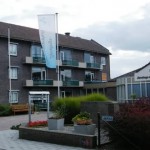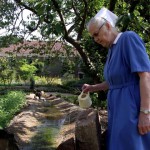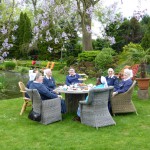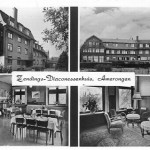Netherlands: Zendings Diaconessenhuis Amerongen
Zendings-Diaconessenhuis Bethanië
Motto: “Receive and transmit heart and hands.”
Address: Jan van Zutphenweg 4, 3958 GE Amerongen
Telephone: (0343) 723 780; Fax: (0343) 723 782
Web: http://www.zdh.nl. Email: info@zdh.nl
Facebook: https://www.facebook.com/Zendingshuis

Celebrating 60 years as a deaconess

Sister Irene
On April 30th, 2015, Sister Irene Brunsveld celebrated 60 years as a deaconess. She was born in Bocholt, Germany. When she was 15, she heard a sermon about God prompting Abram to leave his home and move to a new country. That appealed to her enormously. From that moment on, she wanted to put her life at the service of God. Being only 15, her parents thought she was too young for such a drastic choice. But a long conversation one evening made them realize how serious young Irene was about what she felt God was calling her to do. She was only 16 when she completed a diaconal year in a supportive environment, and had the opportunity to learn to speak the Dutch language. In her ministry, she was available for young and old, healthy and sick, rich and poor. She was a kindergarten teacher, youth worker, and worked in several centres for the elderly, and nursing home aged care. She was able to open up faith conversations about with people, including terminally ill patients.
Sister Irene has always related her ministry to a watering can: Just as a watering can keeps plants alive, so she wants to water those experiencing difficult times with her love, kindness and compassion – where there is need, to be present with hands and heart. ‘This is only possible if we receive and remain connected to the source of living water’.
 Now 76, Sister Irene is far from silent, or ‘retiring’. She does a lot of pastoral care. She makes visits to people in Amerongen. She has an extensive network of acquaintances, and visits the retired sisters who live in Elim. As she looks back on her years of diaconal service, she reflects: ‘It’s been worth it. I’ve had a rich life, and enjoy every day of God’s faithfulness and good care’.
Now 76, Sister Irene is far from silent, or ‘retiring’. She does a lot of pastoral care. She makes visits to people in Amerongen. She has an extensive network of acquaintances, and visits the retired sisters who live in Elim. As she looks back on her years of diaconal service, she reflects: ‘It’s been worth it. I’ve had a rich life, and enjoy every day of God’s faithfulness and good care’.
Sister Irene leads the deaconesses in Amerongen.

Johanna Bock
History
The history begins in East Prussia in the 19th century where groups of young women put their lives in service to God. On October 20, 1899 the first Missionary Diaconessenhuis was opened in Borken, West Germany. A large number of young deaconesses settled in this house, who in word and deed preached the gospel.
In 1923 , the German sister Johanna Bock came to the Netherlands. She held many meetings for the Netherlands CE (Young People’s Society of Christian Endeavour), which had been introduced around 1908 by two Dutch reformed ministers. However, there was strong opposition, which caused CE to remain small in the Netherlands. Several societies consisted of German girls, who worked as maids in the Netherlands. Johanna Bock, a German deaconess and CE member, worked with those girls in a network of ‘jugendbunde‘ from 1924. In the course of the massive migration of German young women to the Netherlands to work as maidservants, religion for many of them became inextricably linked with nationality and with processes of identification between the leading Sisters and their female flock. (Reference: Religious Voices in Self-Narratives:Making Sense of Life in Times of Transition, edited by Marjo Buitelaar, Hetty Zock)
Johanna Bock went on to found the Dutch deaconess work, and a large number of women who attended the CE meetings became deaconesses. They lived in the Missionary Diaconessenhuis in Amerongen, which opened on May 1, 1935. In the prewar period, there were many guests for all kinds of conferences. The house was too small, and the sisters moved out of their rooms for the guests, and sl ept on straw mattresses. In 1938, an extension was added to the house.
ept on straw mattresses. In 1938, an extension was added to the house.
On December 1938, German maidservants who had remained in the Netherlands and who had not exchanged their citizenship from German to Dutch (usually by marriage) were summoned to return to Germany by February 1939. If the women refused to leave, they were told they could lose their German citizenship altogether. The beginning of the war made it unsafe for the German women remaining in the Netherlands.
From 1943, during WW2, the Missionary Diaconessenhuis was used by the Germans, and then in 1945 by Canadian officers. After the war, the deaconesses had an urgent request to nurse TB patients. From 1945, the deaconesses nursed hundred patients – 50 in the Missionary Diaconessenhuis and 50 in the so called Emergency Sanatorium. It was only in 1955, when the worst was over, that the Emergency Sanatorium was closed.
A few outposts were opened after the war. These outposts served nursing homes and convalescent homes – Huize Oranjestein (Amerongen), Huize Irene (Den Haag), House de Schutse (Wells), Heavenly Mountain (Oosterbeek) and Ziekeninrichting Peniel (Rotterdam) .
Two of the barracks of the former TB sanatorium in Amerongen Emergency Sanitorium were opened in 1955 for the reception of guests, and for evangelism and Bible Camps for children and youth.
In 1955, Sister Johanna Bock was appointed Knight in the Order of Orange-Nassau in recognition of her commitment to both friend and enemy during the war. During this time they were many deaconesses employed in the outposts. In 1962, the sisters organised their own training program. In 1978, Sister Johanna transferred the leadership of the community to Sister Francine van der Meer.
Sister Francine focussed a greater emphasis on evangelism and missions. She gave a priority to more openness to other denominations beyond the Dutch Reformed Church. More people came to live in the Amerongen village. Rev. G. Kaastra was appointed in 1971 as pastor of the Missionary Diaconessenhuis and in 1976 he was appointed as the first and only home father of deaconesses – a good decision!
A milestone was reached with the construction of the nursing home at the Elim Missionary Diaconessenhuis. On February 2, 1977 Sr. Johanna Bock laid a Bible along with bricks in the foundation. On September 1, 1978 , the official opening took place. Elim is intended for retired deaconesses and people involved in the community as deaconesses.
From 1978, the outposts gradually closed or were divested for various reasons. The sisters actively supported CE societies until the 80’s, though the few remaining CE societies dwindled around that time.
In 1980 , Sister Johanna, after having been 66 years deaconess, was brought home by her Lord.
Despite these difficult times , there was a bright spot. In 1985 the inauguration took place of the new motherhouse in Amerongen. In 1984, in Rubengera (Rwanda), a sister community named Abaja ba Kristo ( = handmaids of Christ) was founded . Surprisingly, a new post was set up again in 1995 in Amsterdam, ’t Arendsnest, which offers pastoral and psychosocial support to men and women between 20 and 45 years.
In 2000, the sister community endured another turbulent time, which gave rise to a new initiative. Given the changing society and the small number of active sisters in the community, thought was given to attracting short-term deaconesses. This has turned out to be a good initiative, and has enabled the sisters to providing formation for the younger deaconesses.
In 2009 merged ‘t Arendsnest with Timon Foundation.
With a view to the future, Sister Johanna said on the 40th anniversary of the community (and this is still true today): ” If we looked to ourselves for trust, we would not get very far on our own. But there is Jesus and He says through His Word : “Did not I tell you that you if you believe, you will see the glory of God ?” If you believe! That’s where it comes down to. Faith is the assurance that we need not show up on storm and waves, but that the waves call us to venture into trusting him who keeps his word.”
Key issues and challenges in the contemporary ministry context
In the 21st century, some would feel that there may be no future for the ministry in its old form. In 2002, the sisters made a strategic plan to build a community for couples and singles who wish to support the sisters with tasks in the field of mission, diaconate, pastoral care and evangelization and at the same time develop new activities. In this way, the sisters hope to be able to pass on their legacy.
How many diaconal ministry agents are there currently in the denomination or church agency? Any comment on trends in numbers?
There are only about 7 deaconesses in the association, many of them senior in age.
The number of younger sisters is small and insufficient to staff all the outposts.
Title: The Deaconesses are addressed as ‘Sister’.
Who are the current leaders in the diaconal association?
Sister Johanna Bock leads the deaconesses in Amerongen.
Customary uniforms
The Sisters wear a traditional outfit – blue dress, white collar, and white cap.




Community
The sisters live in community, which they describe as like a Protestant monastery, or like the German motherhouses. They also open their community to others, and especially the serenity. ‘Silence is scarce. We live in a hectic, busy society. The need for silence is greater than ever. Silence and attention are needed to keep in touch with ourselves and God, to reflect on the key issues in life’.

Are diaconal ministry agents able to be married?
Deaconesses choose not to get married because they want to spend all their time and energy in the service of God and neighbour.
Main tasks and responsibilities
The deaconesses devote themselves to working with children and youth, they support chronically ill elderly people, and work in maternity and nursing services. They may organize faith-building conferences; vacation programs; lectures on evangelism and distribution of evangelism literature; and offer pastoral and psychosocial support.
Relationship of diaconal ministry agents to a denomination/church agency
It is an inter-denominational organisation.
Other information to be collected includes (but is not limited to) the following questions.
Diaconal ministry agents: consecretrated/commissioned/ordained/other?
Historical information and dates re formation/recognition of diaconal ministry agents in the denomination/church agency.
Are they remunerated?
Training
What kind of training/formation do diaconal ministry agents receive before formal recognition in their church. Are there expectations of ongoing training, or professional development? If yes, what is expected and how often does it happen?
Are there key people (historical or current) in the organization who have provided significant leadership. Any weblinks to their story, or a short write up?
Are they located within a church, a particular facility or agency, or community based? Are diaconal ministry agents appointed to individual placements or work together on projects or in institutions?
Are diaconal ministry agents able to preside at sacraments (communion, baptism, weddings etc)?
Who makes the appointments for diaconal ministry agents eg they apply for positions, they are appointed (eg by a Bishop, by the conference office, or another body/committee).
Is there a length of time for appointments (eg usually less than 5 years, usually between 5 and 10 years, at the discretion of the diaconal ministry agent or at the discretion of the appointing body), appointed to and remain with a particular mother house, etc.
Do diaconal ministry agents organize conferences, seminars, gatherings for professional development, pastoral peer support etc? How often and what is the nature of these events?
Do the diaconal ministry agents have ‘code of conduct’ or ‘code of ethics’ that inform ethical and behavioral expectations for ministry?
Key documents (historical, vision and mission etc) – links or PDF or Word files
Links to relevant articles, websites etc
Other areas of interest……
(information to Rev Sandy Boyce, President, DIAKONIA World Federation, sandyeboyce@gmail.com, to upload to this website)
